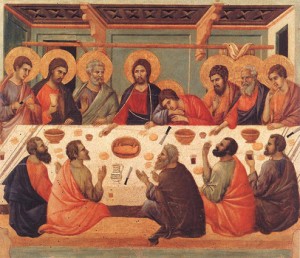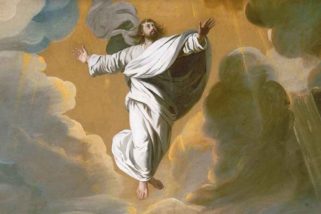Newly discovered ancient Christian magical spell reveals Egyptian influence (by D.M Murdock/ Acharya S)
An ancient Christian magical spell or charm from the sixth century has been found in an old papyrus manuscript housed at the John Rylands Library in Manchester, England. The discoverer, Dr. Roberta Mazza, believes the Greek charm, originally unearthed in Egypt, was part of an amulet to be worn or carried as protection, as reported by Phys.org:
The remarkable document uniquely contains some of the earliest documented references to the Last Supper and ‘manna from heaven’. It is the earliest surviving document to use the Christian Eucharist liturgy – which outlines the Last Supper – as a protective charm….
It shows how Christians adopted the ancient Egyptian practice of wearing amulets to protect the wearer against dangers. This practice of writing charms on pieces of papyrus was continued by the Christians who replaced the prayers to Egyptian and Greco-Roman gods with extracts from the Bible….
The document had been held at the library since around 1901, but its significance had not been realized until Dr Mazza spotted it. She said: ‘This is an important and unexpected discovery as it’s one of the first recorded documents to use magic in the Christian context and the first charm ever found to refer to the Eucharist – the last supper – as the manna of the Old Testament. The text of the amulet is an original combination of biblical passages including Psalm 78:23-24 and Matthew 26:28-30 among others.
‘To this day, Christians use passages from the bible as protective charms so our amulet marks the start of an important trend in Christianity….
‘It’s doubly fascinating because the amulet maker clearly knew the Bible, but made lots of mistakes: some words are misspelled and others are in the wrong order. This suggests that he was writing by heart rather than copying it.
‘It’s quite exciting. Thanks to this discovery, we now think that the knowledge of the Bible was more embedded in sixth century AD Egypt than we previously realized.’…
The full text of the papyrus:
Fear you all who rule over the earth.
Know you nations and peoples that Christ is our God.
For he spoke and they came to being, he commanded and they were created; he put everything under our feet and delivered us from the wish of our enemies.
Our God prepared a sacred table in the desert for the people and gave manna of the new covenant to eat, the Lord’s immortal body and the blood of Christ poured for us in remission of sins.
Despite such discoveries demonstrating the relationship between Christianity and the massive and long-lived Egyptian civilization, which dominated the Mediterranean for centuries, there remain in the contentious fields of Christian origins and Bible scholarship those who insist that Egypt had little to no influence on Christianity!
Egyptologists on Egypt’s Role in the Origins of Christianity
In reality and as shown by the enormous amount of evidence in my book Christ in Egypt: The Horus-Jesus Connection, there are many important and profound parallels between the Egyptian religion and Christianity – some of them quite stunning, in fact. Indeed, many Egyptologists themselves have noted these correspondences, and some of these scholars were so certain of a relationship that they tried to prove the Egyptians had anticipated Christianity in its doctrines and traditions.
In this regard, in Egyptian Religion (251) Egyptologist Dr. Siegfried Morenz, a director of the Institute of Egyptology at the University of Leipzig, declared:
The influence of Egyptian religion on posterity is mainly felt through Christianity and its antecedents.
In Osiris: Death and Afterlife of a God (xii), Egyptologist Dr. Bojana Mosjov asserts Egyptian (and Greek) influence and locates the early Christian effort at Alexandria, Egypt, a city I contend also was the crucible of Christianity:
It was in Roman Alexandria (30 BC-AD 394) that the new Christian religion blossomed, inspired by the writings of the Egyptian, Greek and Jewish philosophers.
The parallels between Egyptian religion and Christianity are discussed in detail by Egyptologist Dr. Erik Hornung, a former professor of Egyptology at the University of Basel who has been called “the world’s leading authority” on ancient Egyptian religious texts. In his book The Valley of the Kings (9), Hornung writes:
…it is not improbable that even early Christian texts were influenced by ideas and images from the New Kingdom religious books.
In The Secret Lore of Egypt: Its Impact on the West (73), Hornung is adamant about Egyptian influence on Christianity:
Notwithstanding its superficial rejection of everything pagan, early Christianity was deeply indebted to ancient Egypt. In particular, the lively picture of the ancient Egyptian afterlife left traces in Christian texts; thus, among the Copts, and later in Islam, we encounter a fiery hell quite like that of the Egyptians… The descensus [descent] of Jesus, which played no role in the early church, was adopted into the official Credo after 359, thanks to apocryphal legends that again involved Egypt. Christ became the sun in the realm of the dead, for his descent into the netherworld had its ultimate precursor in the nightly journey of the ancient Egyptian sun god Re…
Here we see also the solar origins of the Christ myth. More information on that subject can be found in my ebook Jesus as the Sun throughout History and video “Jesus Christ, Sun of Righteousness.”
Egyptian Influence on Rome
As part of Egypt’s impact on the West, which includes Rome, Hornung (SLE, 70) discusses the Egyptian religion’s inroads into the highest strata of Roman society during the alleged time of Christianity’s founding, influencing several Roman emperors such as Claudius, Nero, Otho, Vespasian and Titus:
Claudius [10 BCE-54 AD/CE] was also positively disposed toward Egyptian religion, and Nero expressed interest in the sources of the Nile. Nero also had an Egyptian teacher, Chaeromon, who saw to the dissemination of Egyptian knowledge at Rome. According to [Roman historian] Suetonius, Otho (69 C.E.) was the first Roman emperor to participate publicly in the cult of Isis. Notwithstanding his well-known stinginess, Vespasian [9-79 AD/CE] dedicated a large statue of the Nile to Rome, after a Nile miracle occurred during his visit to Alexandria in the year 69. Together with his son Titus, he spent the night before their triumph over Judea (71 C.E.) in the temple of the Roman Isis, which was first depicted on Roman coins that year. Titus is probably the anonymous ‘pharaoh’ depicted in front of the Apis bull in the catacombs of Kom el-Shuqafa in Alexandria. From the reign of Domitian on, Apis was represented on imperial coins.
There is much more about the Egyptian influence throughout the Roman Empire during the period in question, a substantial amount of which I provide in Christ in Egypt.
Egypt and Judaism
In my book Did Moses Exist? The Myth of the Israelite Lawgiver, I include a significant amount of data demonstrating the centuries-long influence of Egypt on Christianity’s Semitic precursor, Judaism. This correlation has been noticed also by Egyptologists, such as respected German scholar Dr. Jan Assmann, a professor of Egyptology at the University of Heidelberg and the University of Konstanz, who “suggests that the ancient Egyptian religion had a more significant influence on Judaism than is generally acknowledged.”
Another Egyptologist who points out Egyptian priority of “Judeo-Christian” concepts is Dr. Ogden Goelet, a professor of Egyptian language and culture at New York and Columbia Universities. In his well-known edition of The Egyptian Book of the Dead (18), Goelet states:
The Book of the Dead promised resurrection to all mankind, as a reward for righteous living, long before Judaism and Christianity embraced that concept.
To assert that Judaism and Christianity “embraced” the notion of resurrection indicates Goelet believes the idea was passed along from the Egyptian religion to Judaism and Christianity.
Egyptian and Christian Ritual
The Egyptian influence on Christianity includes rituals, as mentioned in “The Baptism of the Pharaoh” by Sir Dr. Alan H. Gardiner, one of the premier British Egyptologists of his day:
The analogy of our rite to that of Christian baptism is close enough to justify the title given to this article. In both cases a symbolic cleansing by means of water serves as initiation into a properly legitimated religious life.
To insist that correlations in doctrines, rituals and traditions between these highly intertwined religious cults are either non-existent or unimportant ranks as fallacious and unscientific.
Osiris, Isis and Horus
Important Egyptian myths too are indicated for Christian origins. In Death and Salvation in Ancient Egypt (115-6), Assmann remarks:
“Salvation” and “eternal life” are Christian concepts, and we might think that the Egyptian myth can all too easily be viewed through the lens of Christian tradition. On the contrary, in my opinion, Christian myth is itself thoroughly stamped by Egyptian tradition, by the myth of Isis and Osiris, which from the very beginning had to do with salvation and eternal life. It thus seems legitimate to me to reconstruct the Egyptian symbolism with the help of Christian concepts. As with Orpheus and Eurydice, the constellation of Isis and Osiris can also be compared with Mary and Jesus. The scene of the Pieta, in which Mary holds the corpse of the crucified Jesus on her lap and mourns, is a comparable depiction of the body-centered intensity of female grief, in which Mary is assisted by Mary Magdalene, just as Isis is assisted by Nephthys. Jesus also descended into the realm of death, though he did not remain there… Osiris remained in the netherworld, but he was resurrected and alive…
Hornung also discusses the influence of Egyptian myths on Christian tradition and iconography:
…The Christian slayer of the dragon had its model in the triumph of Horus over Seth, and there was a smooth transition from the image of the nursing Isis, Isis lactans, to that of Maria lactans. The miraculous birth of Jesus could be viewed as analogous to that of Horus, whom Isis conceived posthumously from Osiris, and Mary was closely connected with Isis by many other share characteristics…. (Secret Lore of Egypt, 75)
He further says:
There was an obvious analogy between the Horus child and the baby Jesus and the care they received from their sacred mothers; long before Christianity, Isis had borne the epithet ‘mother of the god.’ (SLE, 60)
Another modern professional scholar, Dr. Richard A. Gabriel, specifies the influence on Christianity as coming from the cult of the Egyptian god Osiris (Jesus the Egyptian, 2):
…the principles and precepts of the Osiran theology of Egypt are virtually identical in content and application to the principles and precepts of Christianity as they present themselves in the Jesus saga.
In this same regard, Dr. James S. Curl, a professor emeritus at the Queen’s University of Belfast, concludes (The Egyptian Revival, 66):
The Christian religion, it might be proposed, owes as much to the Nile as it does to the Jordan, and for the Church Alexandria should be at least as important as Jerusalem (whereas Rome absorbed influences from both cities). In both Western and Eastern iconography the attributes of Isis survived. Coptic stelai show the Mother and Child, identified as Christian by the Greek crosses on either side of the head, but the basic iconography of the image is that of Isis and Horus, translated into Mary and Jesus….
Parallels Known for Decades to Centuries
These various modern scholars confirm the contentions of older authorities, such as Sir Dr. E.A. Wallis Budge, a well-respected Egyptologist who ran the Department of Egyptian and Assyrian Antiquities at the British Museum. Budge wrote many times about the blatantly obvious correspondences between the Egyptian religion and Christianity, emphasizing the deities Osiris, Isis and Horus, as in Egyptian Ideas of the Future Life (48):
In Osiris the Christian Egyptians found the prototype of Christ, and in the pictures and statues of Isis suckling her son Horus, they perceived the prototype of the Virgin Mary and her Child. Never did Christianity find elsewhere in the world a people whose minds were so thoroughly well prepared to receive its doctrines as the Egyptians.
In Egyptian Tales and Romances (12), Budge comments:
The Christian Trinity ousted the old triads of gods, Osiris and Horus were represented by our Lord Jesus Christ, Isis by the Virgin Mary, Set the god of evil by Diabolus [Satan]…and the various Companies of the Gods by the Archangels, and so on.
Budge’s parallels discussion continues in “The Cult of Isis and the Worship of the Virgin Mary compared” (Legends of Our Lady Mary, 1):
It has been well said that the Egyptians were better prepared to receive and accept Christianity than any of the nations round about them. For thousands of years before St. Mark came to Alexandria to preach the Gospel of his Master Christ, the Egyptians believed in Osiris the Man-god who raised himself from the dead. He was held to possess the power of bestowing immortality upon his followers because he had triumphed over Death, and had vanquished the Powers of Darkness. He was the Judge of souls and the supreme lord of the Judgment of the Dead; he was all-wise, all-knowing, all-just, and his decrees were final and absolute. No man could hope to dwell with him in his kingdom unless he had lived a life of moral excellence upon earth, and the only passports to his favour were truth-speaking, honest intent, and the observation of the commands of the Law (Maat), coupled with charity, alms-giving and humane actions…
In The Gods of Egypt (I, xv-xvi), Budge remarks:
…at the last, when [Osiris’s] cult disappeared before the religion of the Man Christ, the Egyptians who embraced Christianity found that the moral system of the old cult and that of the new religion were so similar, and the promises of resurrection and immortality in each so much alike, that they transferred their allegiance from Osiris to Jesus of Nazareth without difficulty. Moreover, Isis and the child Horus were straightway identified with Mary the Virgin and her Son, and in the apocryphal literature of the first few centuries which followed the evangelization of Egypt, several of the legends about Isis and her sorrowful wanderings were made to centre round the Mother of Christ. Certain of the attributes of the sister goddesses of Isis were also ascribed to her, and, like the goddess Neith of Sais, she was declared to possess perpetual virginity. Certain of the Egyptian Christian Fathers gave to the Virgin the title “Theotokos,” or “Mother of God,” forgetting, apparently, that it was an exact translation of neter mut, a very old and common title of Isis.
As we can see, Egyptologists and other scholars across a long period have contended that Christianity was influenced significantly by the Egyptian religion.
The Egyptian Goddess and Virgin Mary
The role of the Egyptian goddess in the formation of Christianity is examined in Isis in the Ancient World by Egyptologist Dr. Reginald E. Witt, a professor at the University of London, who states (273):
The Egyptian goddess who was equally ‘the Great Virgin’ (hwnt) and ‘Mother of the God’ was the object of the very same praise bestowed upon her successor [Mary, Virgin Mother of Jesus].
In my book Christ in Egypt, I provide much more information on the virgin-mother status of Isis, syncretized to the parthenogenic goddess Neith and others throughout antiquity. I also show how Isis bore the epithet Meri or Mery, meaning “beloved.”
Elsewhere in Isis in the Ancient World (272), Witt makes many other comparisons:
In Hopfner’s invaluable collection of the literary sources, Isis needs more pages of the Index than any other name. A brief glance at her attributes as there listed reveals her sharing titles with the Blessed Virgin whom Catholic Christianity has ever revered as Mother of God. Some of these resemblances may be set aside as [sic] once as commonplace. Yet so many are the parallels that an unprejudiced mind must be struck with the thought that cumulatively the portraits are alike. Indeed, one of the standard encyclopedias of classical mythology specifically deals with Isis identified with the Virgin Mary.
Let us observe a few of the resemblances. Isis and Osiris, as we have so often seen, are mythologically interfused. In the language of the Roman Church the Blessed Virgin Mary is ‘sister and spouse of God: sister of Christ.’ Christian writers identify Sarapis with Joseph and then make Isis ‘wife of Joseph.’ Like her heathen forebear the Catholic Madonna wears a diadem. She too is linked with agricultural fertility…
Witt continues with a long list of comparisons between Mary and not only Isis but also other goddesses, such as the Roman Juno and Minerva. The list of parallels, in fact, goes on for several pages and includes both the Christian and Egyptian figures being at once “the Great Virgin” and “Mother of God.” Witt further remarks:
Convincing examples can be found of the influence on Christian iconography of the figure of Horus/Harpocrates, both in his mother’s company and on his own. The most obvious parallels appear when we compare the ways in which the sacred Mother and Child of Egypt are portrayed and the types of the Theotokos/Madonna together with the infant Jesus in Byzantine and Italian ecclesiastical art…
Witt proceeds to name several pieces of art demonstrating the obvious link between the earlier Egyptian gods and the later Christian characters.
Amulets and Esoterica
Bringing us back to the subject of magical charms and amulets, Hornung discusses other such religious artifacts, revealing even more correlations between Egyptian religion/myth and Christianity:
Devotion to the folk god Bes was especially tenacious. Amulets bearing his image have been found in Christian graves, and Bes and Christ are equated in a Coptic magical papyrus…
On another amulet, one side depicts the head of Christ and scenes from the New Testament, and the other a winged, youthful god (Horus-Shed)… There was also an association of the passion of Jesus with traditions regarding Osiris, especially in the Gospel of Nicodemus, with its detailed description of a descent into Hades. (SLE, 75-76)
Hornung also cites more esoteric and apocryphal Christian traditions corresponding to Egyptian religion, as part of Coptic Christianity:
Many legends grew up around the sojourn of Jesus and his parents in Egypt… He was greeted by dragons and lindworms, whom He affectionately caressed. He causes His mother to wade through a stream without getting her feet wet, commanded a salted fish to leap back into the water, healed the sick with the touch of his diaper, bade graven images to fall from their columns, and so forth. Entirely ‘ancient Egyptian’ was the miracle of the tree, in which a palm bowed down before Mary and her child, so that they might conveniently eat of its fruits, just as the goddess in tombs of the New Kingdom had offered her gifts to the deceased. These legends lie outside of the ‘canonical’ gospels, but they were often illustrated in Christian art of the late Middle Ages…
Naturally enough, Coptic Christians had many legends about Jesus’ stay in their land….
As early as Origen’s Contra Celsus (I, 28), we encounter the claim that it was in Egypt, and specifically as an adult laborer, that Jesus had learned all the magical arts with which he worked miracles and on which he based his divinity. This tradition also occurred in early rabbinic literature, but it was of course suppressed in official Christianity… (SLE, 76)
The Coptic Christian legends of Jesus in Egypt are “natural enough” because there is an enormous amount of correspondence between Christianity and the Egyptian religion.
As we can see, the influence of Egypt on Christianity has been observed for a long time by respected and credentialed authorities. It is therefore irrational and unscholarly to deny this connection, which is likewise well known from the pervasive influence of the Egyptian Gnostics Valentinus and others at Alexandria during the second century, when the Christian effort truly took shape.
From that point on, Egypt repeatedly influenced Christianity, including in its iconography, such as the Egyptian “Madonna and Child” motif of Isis with her baby, Horus. This latest discovery of an Egyptian-inspired Christian magical charm is important and fascinating, as another one small piece of evidence for what amounts to substantial influence from the very beginning of Christianity’s foundation.



